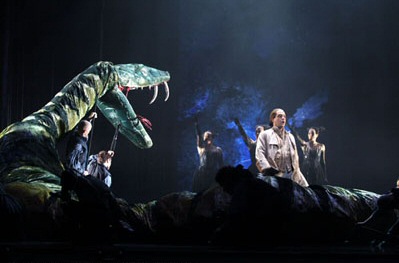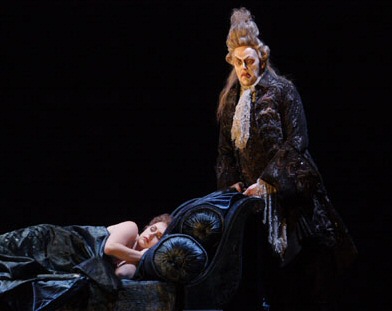Seen and Heard Recital
Review
MOZART, Die Zauberflöte
Soloists, Orchestra of the Royal Opera House, dir. Charles Mackerras,
Royal Opera House, Covent Garden, February 14th 2005 (ME)
‘Tis through Love that atom pairs with atom,
In a harmony eternal, sure;
And ‘tis Love that links the spheres together
Through her only, Systems can endure.
Were she but effaced from Nature’s clockwork,
Into dust would fly the mighty world;
O’er thy Systems thou wouldst weep, great Newton
When with giant force to Chaos hurl’d! (Schiller)
Third time around for this Enlightenment production, first seen
as recently as 2003, and it’s a remarkable third show on
at the moment for the lighting director Paule Constable, who also
lights what are arguably the two other keynote London productions
now onstage, ENO’s La
Clemenza di Tito and the Don Carlos at the Gielgud
Theatre, in which Derek Jacobi is giving the performance of a
lifetime. I have been fortunate enough to have seen all three
within the space of ten days, and they have much in common quite
apart from their lighting, notable though that is.

Schiller’s play, given in a new translation (not universally
liked) by Mike Poulton, is substantially about the struggles of
humanity to transcend ‘the imprisonment of men’s minds’
and concerns the duties of a sovereign towards his people and
the future of his nation, themes shared by both these Mozart operas,
but where Schiller shows the ruin of idealism and the ascendancy
of authoritarianism, Mozart gives us the triumph of the human
spirit as expressed in what Hardy’s Tess eloquently refers
to as ‘lovingkindness.’ All three productions make
much use of opposing images of light and darkness, the Schiller
dominated by the cold grey of the prison-like court, into which
the only penetrating colours are the brightness of daylight streaming
in through the barred windows, and the terrifying emergence of
the carmine-clad Grand Inquisitor, his ‘light’ paradoxically
the worst darkness of all: the minimalism here was far more successful
than the rather over-laden imagery of ‘Tito,’ but
Zauberflöte succeeded where the production of the
earlier opera failed in that its use of iconography was intelligent,
meaningful and, in the best sense, illuminating.
David McVicar does not offer a cosy, pantomime style, ‘magical’
version of the ‘Flute,’ but a serious attempt to take
the music and libretto on its own terms – that is, as a
discussion about the ways in which mankind may attain enlightenment,
either in the sense of ‘erleuchtung’ (spiritual) or
‘aufklarung’ (rational), and most of the imagery was
drawn from what might be called the usual ‘myth-kitty’
– as is often the case with this director, but here the
assorted symbols did not jar as they did in ‘Tito.’
John Macfarlane’s lavish designs were in fact the mainstay
of this staging – certainly giving reason enough for me
to deviate from my usual style of commenting first about the singers
– that, and the fact that the singing was largely not at
the level I would expect from the world’s leading lyric
theatre.
Lovers of Dutch interiors would feel at home chez Sarastro, with
grey-bustled little girls scurrying about and richly panelled
walls reflecting mellow candlelight, and of course those acquainted
with Joseph Wright of Derby’s famous work The Orrery would
instantly recognize the setting of the room where Sarastro muses
upon the fate of Tamino. The Orrery – a model of the solar
system first made in 1700 and given its name after the Earl of
Orrery – is finely reproduced onstage in gentle, inexorable
motion, an image beautifully pointed up by the backdrop of the
constellations in the night sky when the Queen appears. Heavens,
I hear you say – what is this? Coherent, joined up imagery
on an opera stage? Well, it does happen.
There was much else to delight the eye and intellect: the daftly
foppish retinue surrounding Monostatos, all of them probably going
by names like Sir Courtly Nice and Sir Fopling Flutter –
quite appropriate in the production’s 18th century urban
context, the clean-sliced sickle moon, looking like Larkin’s
‘air-sharpened blade’ which dominates the stage as
the Queen enters; the wonderfully ornate beds, like something
out of the original illustrations to ‘Sleeping Beauty;’
the luminous, golden glow suffusing the initiates at the end –
that lighting again – and most interestingly the giant eye
framed by light, presumably symbolizing the true vision which
has been attained: an image presumably taken from Goethe’s
‘Optical Essays’ of 1792 in which he shows his own
eye in a blaze of glory, looking down onto the defeated scientific
instruments of the ‘Newtonians.’ Appropriate, of course,
since here truth and vision have indeed conquered rationalism.
And the singing? Simon Keenlyside’s Papageno was the best
live portrayal of the role that I have heard, even though there
are times when he seems to be indicating that he could do it in
his sleep: he’s an intensely physical stage actor, literally
throwing himself into his part and creating a completely believable
character, and his vocal prowess matches this. ‘Ein Mädchen
oder Weibchen’ was elegantly as well as endearingly sung,
and his contribution to ‘Bei Männern’ –
even though the two voices did not quite blend as they should
– was forcefully phrased. A very fine performance, and it
was not the evening’s only one, since the American baritone
Kyle Ketelsen made a notable debut as the Speaker: it is this
role which the other great Papageno of our day, Matthias Goerne,
considers to be the most interesting in the work, and Ketelsen
gave it the authority and grandeur which it needs, and his voice
is beautiful, evenly focussed throughout the range and with a
fine, burnished tone.

It was a pity that a similar authority and beauty of tone were
absent from the Sarastro of Jan-Hendrik Rootering, whose stage
presence lacks the required gravitas for this role and whose voice
was far too often lost in his chest: I’m baffled that the
ROH have engaged him for this part again, after his weakly sung
and barely characterized
Hans Sachs. Surely there exists a British bass who could give
this coveted role the centrality which it needs? The casting of
Will Hartmann is almost equally puzzling: are we so short of Taminos
that the House must cast someone with such an unhewn sound and
such evident lack of subtlety in phrasing? The fact that he displays
a vibrato wide enough to throw a medicine ball through it doesn’t
help much either: he has sung the role at Hanover State Opera
and elsewhere, but this is Covent Garden for Heaven’s sake:
I have heard better – and often – at ENO. His Pamina
was the very pretty Welsh soprano Rebecca Evans, whose pedigree
is somewhat more illustrious but whose singing on this occasion
was lacking in focus: the voice has some heft to it, but she often
scooped up to the notes and ‘Ach, Ich fühl’s’
was marred by a rather distancing effect of the singer concentrating
so hard on merely getting the notes out that there was no room
for subtlety with language.
Anna-Kristiina Kaapola’s Queen of the Night was clearly
nervous during her first aria, so many soured notes emerged, but
she recovered to give a piercing account of ‘Der hölle
Rache’ with all four top Fs neatly in place: she did not
convey any sense of menace or domination though, and that is surely
what her coloratura is meant to provide. John Graham-Hall was
a seedy Monostatos, singing with bright tone and incisive phrasing,
and the Three Ladies provided some intermittently fine singing,
with Gillian Webster’s First lady the most consistently
pleasing. The Three Boys had plenty of charm without being too
coy, and the Priests and Armoured men delivered some strong characterization
– good to see the very promising tenor Robert Murray following
up his house debut in Traviata last month. I found the
production’s concept of Papagena (Gail Pearson) mystifying:
she should look like Papageno, yet here she was tricked out in
Chav-style pink vinyl and wide white belt, so that far from breaking
into a duet you half expected her to shriek ‘I’m the
only gay in the village, you know…’ and as for any
sense of the sheer palpitating excitement of that wondrous ‘Pa-pa-pa’
duet, you could forget it – this was rushed as though singers
and orchestra had a train to catch.
In the pit, Mackerras delivered his usual carefully managed, meticulously
pointed account of the score, drawing some lovely playing from
the orchestra who were nonetheless not on their best form –
ENO’s last week put them in the shade: perhaps as the run
settles down, the playing will reach the expected level. As for
the choral singing, there was little to be desired: Renato Balsadonna
had shaped them into a superb ensemble, shining with clarity in
‘O Isis und Osiris’ and at once reverent and ecstatic
in the sublime ‘Heil sei euch Geweihten.’
‘…Freedom dwells but in the realm of visions,
And beauty lives but in the poet’s song.’
Schiller again, and it was unexpectedly in the realm of visions
that this production succeeded, since there was not much beauty
in the singing.
Melanie Eskenazi
Photo Credits: Pamina - Rebecca Evans, Monostatos
- John Graham-Hall, Tamino - Will Hartmann © Catherine Ashmore,
Royal Opera, Covent Garden February 2005




